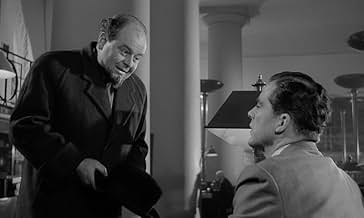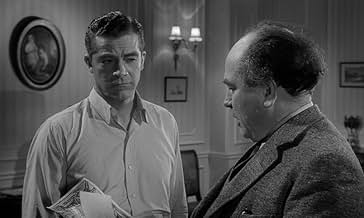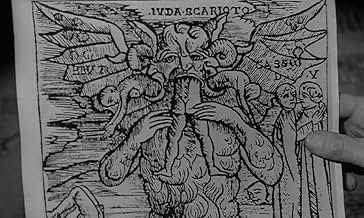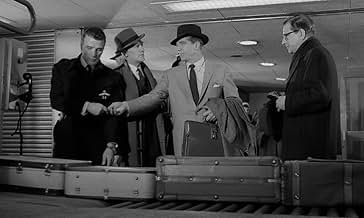IMDb-BEWERTUNG
7,4/10
16.479
IHRE BEWERTUNG
Professor John Holden kommt zu einer Parapsychologie-Konferenz nach London, nur um sich dann in einer Ermittlung gegen den Teufelsanbeter Julian Karswell wiederzufinden.Professor John Holden kommt zu einer Parapsychologie-Konferenz nach London, nur um sich dann in einer Ermittlung gegen den Teufelsanbeter Julian Karswell wiederzufinden.Professor John Holden kommt zu einer Parapsychologie-Konferenz nach London, nur um sich dann in einer Ermittlung gegen den Teufelsanbeter Julian Karswell wiederzufinden.
- Auszeichnungen
- 1 Gewinn & 1 Nominierung insgesamt
Charles Lloyd Pack
- Chemist
- (as Charles Lloyd-Pack)
Empfohlene Bewertungen
Dana Andrews plays the New World skeptic to the point of irritation - but not beyond, but the honours go to Nial MacGinnis whose warlock oozes malevolence, yet you still wouldn't mind enjoying afternoon tea with him. The scene where he waits in the car, opens the door and orders 'come along mother', after the tension of the seance is the icing on the cake. The black and white cinematography only adds to the 'darkness' of the tale. The opening sequence of the story with Denholm Elliot franticly driving through the lonely English countryside builds the tension wonderfully (you peer with a growing sense of foreboding as the headlamps try to beat a path home). I wonder if Hollywood could ever remake this. I doubt it. Throw millions of dollars at it, an A-list leading man and shed-loads of computer wizardry and you wouldn't even come close to the original.
This piece has stuck with me since I saw it as a child in about 1960. Our family enjoyed horror films, and we always thought that this one was memorable. Seeing it again recently, I haven't changed my mind. Given the effects available at the time and the creepiness factor, I've always though this was one of the better of the older horror movies around.
It is quaint, British, and builds slowly after the initial shock. Some comments say it was boring, shouldn't have shown the creature, Dana Andrews was drunk and sucked, etc. It isn't perfect, but like "The Haunting" and a few others made around that time, it succeeds well in creating an unsettling and generally engaging mood, including some humor, on a very small budget. I still think that the creature F/X was excellent for its time. I can imagine the film without seeing the creature, and maybe that would have been even more effective, again like "The Haunting".
I give it "A-" for effort and execution, and for avid horror buffs, it's definitely worth a watch or two. I've tested this one out with some younger folks, and they seem to really like it. Even a jaded younger horror fan used to blatant gore and in your face monsters said, "That creeped me out." FYI, the "Night" vs. "Curse" versions are different by several minutes of extra footage, which I recall was the séance scene and some connective dialog.
It is quaint, British, and builds slowly after the initial shock. Some comments say it was boring, shouldn't have shown the creature, Dana Andrews was drunk and sucked, etc. It isn't perfect, but like "The Haunting" and a few others made around that time, it succeeds well in creating an unsettling and generally engaging mood, including some humor, on a very small budget. I still think that the creature F/X was excellent for its time. I can imagine the film without seeing the creature, and maybe that would have been even more effective, again like "The Haunting".
I give it "A-" for effort and execution, and for avid horror buffs, it's definitely worth a watch or two. I've tested this one out with some younger folks, and they seem to really like it. Even a jaded younger horror fan used to blatant gore and in your face monsters said, "That creeped me out." FYI, the "Night" vs. "Curse" versions are different by several minutes of extra footage, which I recall was the séance scene and some connective dialog.
I thought I had heard awhile back that Jacques Tourneur didn't want to show the demon. Does anybody know if this is so? Having worked with Val Lewton, this would seem possible. If so, it's a shame Tourneur isn't around to put a director's cut on the DVD instead of Curse Of The Demon which is a little redundant being on the same DVD as Night Of The Demon. I found the demon scary when I was 12 years old and would not have enjoyed the film as much without it. Now, of course, the film would seem better without it. The atmosphere of Tourneur's work that I've seen; this,I Walked With A Zombie, Out Of The Past, and that Twighlight Zone episode (one of the best) of the elderly lady getting calls from her deceased husband consistently has that great nocturnal, shadowy and mysterious quality to it. This body of work alone is enough to make him one of my favorite directors. Even if this isn't one of Dana Andrews best performances, his stubborn skepticism is convincing enough to contrast nicely with Carswell's over politeness. As old horror movies go; this ranks up there with The (original) Haunting, Eyes Without A Face, Black Sunday and early Universals as the best among the old black and whites for me. Strangely enough, I happened to have watched it earlier this (yesterday now) evening October 28th which IS the night of the demon. Coincidence? **** out of *****
Psychologist Dana Andrews is on his way from America to attend a convention in London and in answer to a friend's cry for help. In fact we see that friend, Maurice Denham when the film opens up. He's at the house of another scientist Niall McGinniss who's been experimenting big time in the occult. Denham is scared and begging for his life, begging for McGinniss to call off some kind of evil force that is pursuing him.
The evil force gets him of course and when Andrews touches down in the UK he learns from Denham's daughter Peggy Cummins about what has happened to her father. That only arouses Andrews's curiosity.
But the message of Night of the Demon is that there are some things that nature means we should not disturb. Andrews learns that almost too late.
As was typical back in the day, the British film industry to get a wider distribution of their product sometimes imported an American star for their films. In this case Dana Andrews is with an all British supporting cast.
But as another viewer pointed out the film really belongs to Niall McGinniss the scientist who summons up evil forces from another plane of existence he can't control. His comfortable way of living for himself and his mother Athene Sayler comes at a price. McGinniss is charming and deadly at the same time.
Jacques Tourneur learned well at the feet of Val Lewton, the master of such films as these. After over 50 years the film still holds up well. Viewers today will be as scared as they were in 1957.
The evil force gets him of course and when Andrews touches down in the UK he learns from Denham's daughter Peggy Cummins about what has happened to her father. That only arouses Andrews's curiosity.
But the message of Night of the Demon is that there are some things that nature means we should not disturb. Andrews learns that almost too late.
As was typical back in the day, the British film industry to get a wider distribution of their product sometimes imported an American star for their films. In this case Dana Andrews is with an all British supporting cast.
But as another viewer pointed out the film really belongs to Niall McGinniss the scientist who summons up evil forces from another plane of existence he can't control. His comfortable way of living for himself and his mother Athene Sayler comes at a price. McGinniss is charming and deadly at the same time.
Jacques Tourneur learned well at the feet of Val Lewton, the master of such films as these. After over 50 years the film still holds up well. Viewers today will be as scared as they were in 1957.
Dana Andrews as an American psychologist, newly-arrived in England to attend a convention, who ends up investigating the death of a colleague which may stem from witchcraft. Delectably sinister and crafty UK occult entry from director Jacques Tourneur, who creates a shimmering and eerie mood from Hal Chester and Charles Bennett's screenplay. The two writers, adapting Montague R. James' book "Casting the Runes", reportedly quarreled over the occult elements in the script--with Bennett's attempts at a more subtle approach going unrealized (arguably, we get too many close-ups of the titular demon, but he's a scene-stealer nevertheless!). Tourneur weaves this Hitchcockian tale with a great deal of hypnotic style, and gets fine performances from Peggy Cummins as the daughter of the deceased as well as the always-reliable Andrews (one might say the actor seems a bit stolid here but, since his character is a born skeptic, he should look tense and uncomfortable). Niall MacGinnis is nothing short of amazing as Dr. Julian Karswell, sort of a mama's boy/devil cult leader and one of the very best villains in 1950s cinema. Supporting performances are all first-rate, the picture looks fantastic in chilly black-and-white as photographed by Ted Scaife, and the satisfying finale leaves one both smiling and hungry for more. Initially released in the US as "Curse of the Demon", missing 15 minutes from its original running time of 95 minutes. ***1/2 from ****
WUSSTEST DU SCHON:
- WissenswertesJacques Tourneur never planned to show the monster but to leave it instead to the audience's imagination. However, the studio insisted that the monster be shown and added it in post-production, allegedly without Tourneur's consent, approval, or involvement. "The scenes where we really see the demon were shot without me. All except one: I shot the sequence in the woods where Andrews is pursued by this sort of cloud." [Tourneur himself in Midi-Minuit Fantastique 5.65]. He also said, "It should have been unveiled bit by bit without it ever really being shown." [in Cinefantsatique; '73]
- PatzerAt the beginning, when Professor Harrington is driving to Dr. Karswell's residence, the steering wheel is on the left, and the POV is from the passenger seat, looking at the right side of his face. On his way back to his home, it's a mirror image of the original (flipped shot).
Actually, the car is narrow, and it is an optical illusion that the steering wheel on the left. It is a right-hand drive vehicle as can be seen when he looks out the window at the Lufford Hall sign at the gate, as well as when he exits the car at the house.
- Zitate
Professor Henry Harrington: It's in the trees! It's coming!
- Alternative VersionenThis film exists in three English language versions: (1) The original British release under the title "Night of the Demon", (2) Columbia's edited version for release in the U.S. under the title "Curse of the Demon", and (3) over 20 years later, Columbia replaced their edited U.S. version with the original British version but with the title also changed to "Curse of the Demon". Columbia's DVD release contains both the edited and restored U.S. versions. Although the cover remains the same, Columbia's more recent copies of the their DVD release removes the U.S. version with the restored footage with a print of the original British release with the title "Night of the Demon".
- VerbindungenFeatured in Aweful Movies with Deadly Earnest: Curse of the Demon (1970)
Top-Auswahl
Melde dich zum Bewerten an und greife auf die Watchlist für personalisierte Empfehlungen zu.
- How long is Curse of the Demon?Powered by Alexa
Details
- Erscheinungsdatum
- Herkunftsland
- Sprache
- Auch bekannt als
- Night of the Demon
- Drehorte
- Brocket Hall, Lemsford, Welwyn Garden City, Hertfordshire, England, Vereinigtes Königreich(as "Lufford Hall, Warwickshire")
- Produktionsfirma
- Weitere beteiligte Unternehmen bei IMDbPro anzeigen
- Laufzeit1 Stunde 36 Minuten
- Farbe
- Seitenverhältnis
- 1.66 : 1(original aspect ratio & theatrical release)
Zu dieser Seite beitragen
Bearbeitung vorschlagen oder fehlenden Inhalt hinzufügen

Oberste Lücke
By what name was Der Fluch des Dämonen (1957) officially released in India in English?
Antwort

































